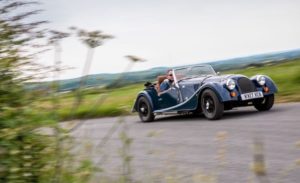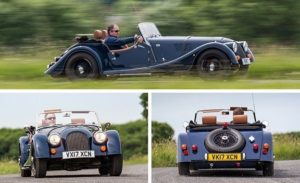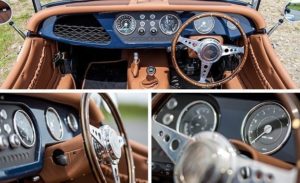2018 Morgan 4/4 – First Drive Review (www.caranddriver.com)
Pretty much an Edwardian Miata.

The idea of giving cars a rapid model cycle and built-in obsolescence was born in the U.S., but it has long since spread to the rest of the world. Few mainstream models are still in production by the time the earliest versions of a generation reach their eighth birthdays, and there likely will have been one or more facelifts or refreshes squeezed into that brief span. The first rule of automotive marketing remains, as always, that this year’s car is the best one.
HIGHS
Suddenly it’s 1936, only with a modern engine.
LOWS
No modern conveniences, nor even any vintage conveniences.
That doesn’t play in Malvern, the small town at the edge of the frequently mispronounced English county of Worcestershire (“Wooster-shire”, the locals say) and home to Morgan Motors for more than a century. Morgan doesn’t change things unless it has to. And, thanks to steady demand for its hand-built sports cars, it rarely needs to. So this 2018 Morgan 4/4—a gleaming press demonstrator with just 1000 miles on the clock when we picked it up—is largely identical to the 2008 version. Or, indeed, the 1998, 1988, or 1978 iterations.

Morgan claims that the 4/4 has been in production for longer than any other car in the world, having been first launched in 1936. Its name referenced the fact that it had both a four-cylinder engine and the then novel (to Morgan) layout of a wheel in each corner, earlier Moggies being exclusively three-wheelers. (We tested a modern Morgan 3 Wheeler a few years back.)
Production of the 4/4 stopped during World War II, and there was another hiatus in the early 1950s. But even if it chose to trace the origins of the current car to the launch of the Series II in 1955—which integrated headlights with the fenders for the first time—it still scores 62 years of continuous construction, making it older than many auto companies. Not to mention many Morgan drivers.
Many details have changed, but the similarities are striking; you could park a modern 4/4 next to its mid-’50s ancestor and struggle to tell them apart. The fundamental construction is identical: a steel chassis with aluminum bodywork fitted over a timber frame (the popular belief that Morgans have structural woodwork is a myth). Suspension is still the archaic combination of sliding pillars at the front and a live axle hanging between two elliptical springs at the back. Disc brakes arrived in the 1960s, but there remain precisely zero driver aids—no ABS, no power steering, not even a brake booster.
Engines have changed through the ages; Morgan has always been agnostic when it comes to powerplants. The Series II launched with a 1.1-liter Ford side-valve engine that produced just 36 horsepower in standard form (40 horsepower with the optional twin-carburetor competition package). The modern car uses a Ford Duratec 1.6-liter inline-four with 110 horsepower that’s pretty much identical to the engine in the base Fiesta as sold in the United Kingdom. This sends torque through a five-speed Mazda manual gearbox, the same transmission that’s fitted to the 3 Wheeler. The 4/4’s lightweight construction and a curb weight of roughly 1900 pounds mean that, in terms of power-to-weight, it’s pretty much an Edwardian Miata.
Elemental Accommodation
The secret of Morgan appreciation is to reset your expectations. By modern standards it is deeply flawed in almost every dynamic regard. But those imperfections add up to something completely different from anything else on the road and—once you get accustomed to some of its most egregious foibles—something that is utterly compelling.
By the standards of vintage cars, the cockpit actually is pretty accommodating. The steering column doesn’t adjust for reach or rake, the footwell is narrow and has some painfully sharp edges, and the floor-hinged pedals are stiff and awkward to use until your ankles adapt to the need to work sideways. The only packaging concession for drivers of different sizes is the ability to slide the seat on its runners, and getting in with the fabric roof in place requires an undignified scramble through the narrow door aperture and around the sizable wood-and-metal steering wheel. Collapsing the roof isn’t a spur-of-the-moment thing, either—our experience involved about three minutes, two swearing fits, and at least one bloody knuckle.

The cabin is narrow enough to have you trading cooties with any passenger. Instrumentation is limited to some appropriately old-fashioned dials (although with modern General Motors–sourced instrument stalks). Trim materials are durable rather than upmarket—Morgan reserves plusher interiors for the more expensive Plus 4 and Roadster models—and there is plenty of evidence that the car has been built by hand, from exposed screw heads to finding occasional bits of swarf from drilled holes strewn about inside. Equipment is limited: Even the plastic side windows come only with the optional upper door halves. (The old word for this is sidescreens.) Our test car had been fitted with a DIN-sized audio player hidden under the dashboard, which proved to be completely inaudible at more than 30 mph. Oh, and although there’s a heater, there are no face-level air vents, the 4/4 predating their invention.
Fat Torque, Skinny Tires
The engine is an unlikely star. In its Ford applications, the Duratec comes across as a utility-grade powerplant that delivers only modest performance. But the lightweight Morgan and sweet-shifting Mazda-sourced gearbox (from the third-generation MX-5 Miata) transform it into something genuinely special, with a free-breathing sports exhaust exiting on the driver’s side for better auditory appreciation. Throttle response is excellent, low-down torque is strong, and the little engine gives its modest all with a zinging enthusiasm. The result is a car that’s not fast per se, but which never feels slow.
The unassisted steering is vein-poppingly heavy if you try to turn the wheel when stationary, but it lightens as soon as the car starts to move. But only for the first half-turn or so of lock, beyond which it firms up again. Constant slight corrections are required to keep the car on course, just like in an old movie, and there’s little feedback beyond vibration that gets through to the rim.
There’s not much for the steering to talk to you about anyway: The period-patterned 165-width Continental tires are positively self-effacing in their lack of grip. The front wheels threaten to lock up under what feels like normal levels of retardation at low speeds. Lateral adhesion feels stronger, but the front tires give up long before the rears. Excessive speed produces understeer rather than anything more exciting; given the slow steering, that’s a good thing. Ride quality is poor, especially on the narrow and bumpy British roads we drove over, with the 4/4 clumping and crashing over even the smallest imperfections, the car’s structure shivering like a wet dog all the while.
Yet, truly, none of this matters. Comparing the Morgan with a modern car is to miss the point entirely. The very modesty of its limits is the key to its appeal. Contemporary cars try to isolate their drivers from distraction, allowing through a carefully controlled amount as officially sanctioned feedback. The 4/4 gives you the lot—noise, vibration, harshness, and (despite the low-cut windscreen’s best efforts) occasional bugs in your hair. It’s like a motorcycle, a vehicle that you have to work with and anticipate both risks and opportunities well ahead of time. A half-hour is a true driving adventure during which 45 mph feels like at least double that, and every successful passing maneuver feels like a race-winning overtake.
A Replica of Itself
While many automakers try to dress themselves in contrived tradition, Morgan wears the real thing. Visitors flock to the Malvern factory to see cars being built using techniques unchanged since its foundation, the company boasting that some workers are fifth- and even sixth-generation employees. And, for all its faults, the 4/4 remains the glorious exemplar of the brand.
Morgan hasn’t sold any of its four-wheeled models in the United States since the Aero 8’s exemption from smart airbags lapsed in 2008, but it is contemplating a return. As we told you last year, the company is seriously looking at bringing back some of its older models under the exemption in the FAST Act for replicas of cars over 25 years of age.
Let’s hope that happens, but let’s also hope that—if it does—Morgan doesn’t change a thing.
